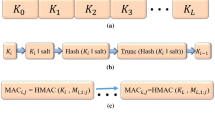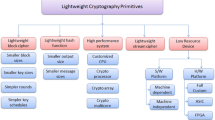Abstract
Radio Frequency Identification (RFID) is a relatively new technology. In recent years, it has been shown to be convenient and feasible in many applications. However, there are security issues which need to be addressed. Due to the wireless transmission of the RFID system, malicious people can gain the information in the RFID tags, and the user’s privacy is invaded. Although there have been many protection methods proposed for RFID security, the system has remained vulnerable to various attacks. In this paper, we propose a conforming of the EPCglobal Class 1 Generation 2 standards RFID ownership transfer protocol with provable security. The proposed scheme can resist several attacks and ensure a secure transaction.







Similar content being viewed by others
References
Chen, C. L. (2010). An “All-In-One” mobile DRM system design. International Journal of Innovative Computing, Information & Control, 6(3A), 897–911.
Chen, C. L., & Deng, Y. Y. (2009). Conformation of EPC class 1 generation 2 standards RFID system with mutual authentication and privacy protection. Engineering Applications of Artificial Intelligence, 22(8), 1284–1291.
Chen, C. L., Chen, Y. Y., & Chen, Y. H. (2009). Group-based authentication to protect digital content for business applications. International Journal of Innovative Computing, Information & Control, 5(5), 1243–1251.
Chen, C. L., Lai, Y. L., Chen, C. C., & Chen, Y. L. (2011). A smart-card-based mobile secure transaction system for medical treatment examining reports. International Journal of Innovative Computing, Information & Control, 7(5A), 2257–2267. ISSN 1349-4198
Chien, H. Y., & Chen, C. H. (2007). Mutual authentication protocol for RFID conforming to EPC class 1 generation 2 standards. Computer Standards & Interfaces, 29(2), 254–259.
Choi, E. Y., Lee, D. H., & Limb, J. I. (2009). Anti-cloning protocol suitable to EPCglobal Class-1 Generation-2 RFID systems. Computer Standards & Interfaces, 1124–1130.
Dietterle, D., & Kraemer, R. (2009). A hardware accelerated implementation of the IEEE 802. 15. 3 MAC protocol. Telecommunications Systems, 40(3–4), 161–167.
Duc, D. N., Park, J., Lee, H., & Kim, K. (2006). Enhancing security of EPCglobal GEN-2 RFID tag against traceability and cloning. In The 2006 symposium on cryptography and information security, Japan, January (pp. 17–20).
EPCglobal web site. http://www.epcglobalinc.org/.
Garfinkel, S. L., Juels, A., & Pappu, R. (2005). RFID privacy: an overview of problems and proposed solutions. IEEE Security & Privacy Magazine, 3(3), 34–43.
Henrici, A. D., & Müller, P. (2004). Hash-based enhancement of location privacy for radio-frequency identification devices using varying identifiers. In Proceedings of PerSec’04 at IEEE PerCom, March (pp. 149–153).
Juels, A. (2005). Strengthening EPC tags against cloning. In Proceedings of the 4th ACM workshop on wireless security (pp. 67–76).
Karthikeyan, S., & Nesterenko, M. (2005). RFID security without extensive cryptography. In Proceedings of the 3rd ACM workshop on security of ad hoc and sensor networks, Virginia, 7 November (pp. 63–67).
Molnar, D., & Wagner, D. (2004). Privacy and security in library RFID: issues, practices, and architectures. In Conference on computer and communications security (CCS’04), Washington, October (pp. 210–221).
Molnar, D., Soppera, A., & Wagner, D. (2006). A scalable, delegatable pseudonym protocol enabling ownership transfer of RFID tags. In LNCS: Vol. 3897. Selected areas un cryptography (pp. 276–290).
Osaka, K., Takagi, T., Yamazaki, K., & Takahashi, O. (2006). An efficient and secure RFID security method with ownership transfer. In IEEE international conference on computational intelligence and security, Japan, November (Vol. 2, pp. 1090–1095).
Pedro, P. L., Cesar, H. C. J., Juan, E. T. M., & Arturo, R. (2009). Cryptanalysis of a novel authentication protocol conforming to EPC-C1G2 standard. Computer Standards & Interfaces, 31(2), 372–380.
Saito, J., & Sakurai, K. (2005). Owner transferable privacy protection scheme for RFID tags. In Proc. of computer security symposium 2005 (CSS2005), Japan, October (pp. 283–288).
Seo, Y., Asano, T., Lee, H., & Kim, K. (2007). A lightweight protocol enabling ownership transfer and granular data access of RFID tags. In The 2007 symposium on cryptography and information security, Sasebo, Japan, January (pp. 23–26).
Wang, X., Guo, W., Zhang, W., Khan, M. K., & Alghathbar, K. (2011). Cryptanalysis and improvement on a parallel keyed Hash function based on chaotic neural network. Telecommunications Systems. doi:10.1007/s11235-011-9457-9.
Weis, S. A., Sarma, S. E., Rivest, R. L., & Engels, D. W. (2004). Security and privacy aspects of low-cost radio frequency identification systems. In LNCS: Vol. 2802. Security in pervasive computing (pp. 201–212).
Yan, X., & Liu, X. (2011). Evaluating the energy consumption of the RFID tag collision resolution protocols. Telecommunications Systems. doi:10.1007/s11235-011-9563-8.
Acknowledgements
This research was supported by the National Science Council, Taiwan, R.O.C., under contract number NSC101-2622-E324-003-CC3 and NSC 101-2221-E-324-005-MY2.
Author information
Authors and Affiliations
Corresponding author
Rights and permissions
About this article
Cite this article
Chen, CL., Huang, YC. & Jiang, JR. A secure ownership transfer protocol using EPCglobal Gen-2 RFID. Telecommun Syst 53, 387–399 (2013). https://doi.org/10.1007/s11235-013-9711-4
Published:
Issue Date:
DOI: https://doi.org/10.1007/s11235-013-9711-4




